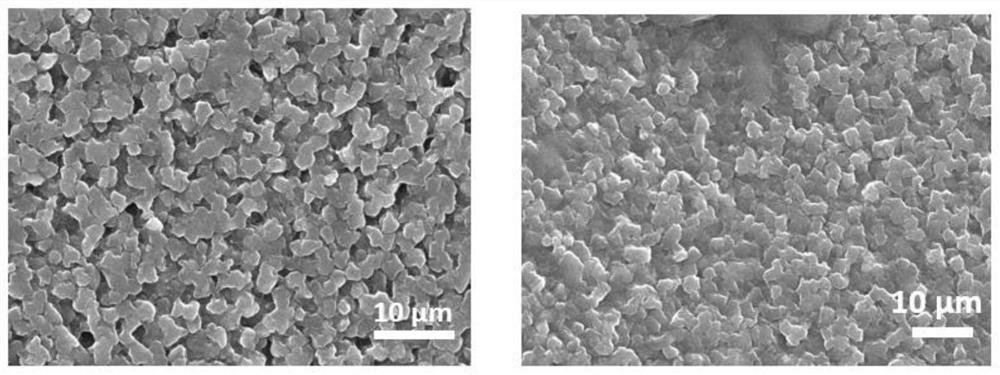Self-repairing solid electrolyte, preparation method and application thereof
A solid-state electrolyte and self-repairing technology, which is applied in the direction of solid electrolyte, non-aqueous electrolyte, non-aqueous electrolyte battery, etc., can solve the problems of poor stability and low applicability of solid-state batteries, and achieve simple preparation process, low cost and easy availability, Process green effect
- Summary
- Abstract
- Description
- Claims
- Application Information
AI Technical Summary
Problems solved by technology
Method used
Image
Examples
preparation example Construction
[0040] In order to solve the above problems, combined with figure 1 , Figure 6 As shown, the embodiment of the present invention provides a method for preparing a self-healing solid electrolyte, and the specific steps are:
[0041] S1, mixing the dissociated lithium salt compound with a solvent, and ultrasonically obtaining a dissociated solution;
[0042] S2. Add the self-healing polymer, cross-linking agent, and lithium salt into the dissociation solution, mix evenly, and heat up to react to obtain a self-healing precursor solution;
[0043] S3. Put the self-healing precursor solution on a polytetrafluoroethylene plate to form a film, and dry it in vacuum to obtain a self-healing solid electrolyte.
[0044] Specifically, in step S1, the dissociated lithium salt compound includes polyethylene glycol, polyvinylidene fluoride, polyvinylidene fluoride-hexafluoropropylene, polyethylene oxide, polypropylene oxide, polypropylene carbonate, poly( At least one of ethylene glycol)...
Embodiment 1
[0060] This embodiment provides a method for preparing a self-healing solid electrolyte, and the specific steps are as follows:
[0061] 1) Preparation of dissociation solution
[0062] 2 g of polyvinylidene fluoride and N-N dimethylformamide (treated with molecular sieves) were uniformly mixed to obtain a dissociation solution.
[0063] 2) Preparation of self-healing precursor solution
[0064] Add 4g of DL-α-lipoic acid, 0.4g of 1,3-diisopropenylbenzene and 0.2g of polyethylene glycol diacrylate to the above dissociation solution, react and stir at 75°C for 10 minutes, then Add 10 mg of anhydrous ferric chloride, and continue heating for a period of time until the anhydrous ferric chloride is completely dissolved in the solution; after cooling to room temperature, add 0.2 g of lithium perchlorate, and stir for 12 hours to obtain a self-repairing precursor solution.
[0065] 3) Preparation of self-healing solid electrolyte
[0066] The self-healing precursor solution was p...
Embodiment 2
[0068] The difference between this embodiment and Embodiment 1 is that this embodiment provides a method for preparing a self-healing solid electrolyte, and the specific steps are as follows:
[0069] 1) Preparation of dissociation solution
[0070] Mix 3 g of polyvinylidene fluoride-hexafluoropropylene and acetonitrile evenly to obtain a dissociation solution.
[0071] 2) Preparation of self-healing precursor solution
[0072] Dissolve 188 mg of lithium bistrifluoromethylsulfonylimide in 812 mg of 1-allyl-3-vinylimidazole bistrifluoromethylsulfonimide salt, stir for 2 hours, and form a lithium salt mixture.
[0073] Add 6g of DL-α-lipoic acid and 1g of lithium salt mixture into the dissociation solution, stir evenly, and after heating at 75°C for 10 minutes, inject 1.2g of 1,3-diisopropenylbenzene and 15mg of Anhydrous ferric chloride was continued to be heated at 75° C. for 30 minutes to obtain a self-repairing precursor solution.
[0074] 3) Preparation of self-healing s...
PUM
| Property | Measurement | Unit |
|---|---|---|
| tensile stress | aaaaa | aaaaa |
Abstract
Description
Claims
Application Information
 Login to View More
Login to View More - R&D
- Intellectual Property
- Life Sciences
- Materials
- Tech Scout
- Unparalleled Data Quality
- Higher Quality Content
- 60% Fewer Hallucinations
Browse by: Latest US Patents, China's latest patents, Technical Efficacy Thesaurus, Application Domain, Technology Topic, Popular Technical Reports.
© 2025 PatSnap. All rights reserved.Legal|Privacy policy|Modern Slavery Act Transparency Statement|Sitemap|About US| Contact US: help@patsnap.com



